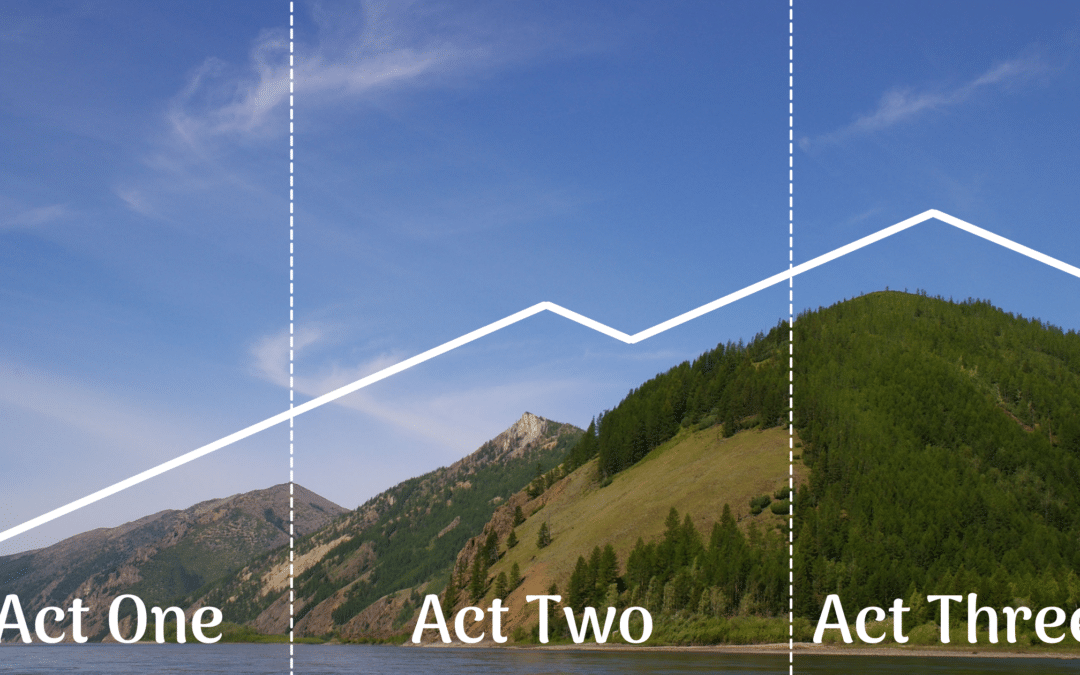In the Western tradition of plays, novels and folktales, the stories of characters we love tend to follow a similar arc. We call this plot scaffold the three-act structure. Originating from Shakespearean plays like “Hamlet” and “Macbeth,” this template can be broken up into the inciting incident, buildup of tension and the fallout from the story’s pivotal scene. The three-act structure, however, is not just a concept for playwrights and English majors. It can also be applied to your business’s content marketing strategy when going through the process of content creation for your business.
In this article, we will integrate the techniques of plot development into your content creation on both the small and broad scales of your content marketing strategy. But in case you’re still not convinced by this nerdy English major, here are three reasons to consider following this structure:
- The format is familiar. When introducing yourself to an audience, whether for a product or a service, you are asking them to step outside of their comfort zone and give your product or service a try over your competition. Even if they are not familiar with the three-act theory itself, your audience is probably already accustomed to the structure through plays, novels, television, movies and more. By using this configuration in your content marketing efforts, your audience will find your pieces more approachable as it is familiar to them.
- Your content marketing will be more experiential. Effective content marketing does more than explain what your product or service can do. Strong content marketing invites the audience member to imagine how your business can fit into their life. Using a format that by its nature takes the audience on a journey will encourage your audience to imagine the ways your business can work for them.
- Storytelling is one of the most effective ways to connect with your audience. People are natural storytellers, and you can bet there is a story they are telling about your brand. Whether you wish to appear as an expert in your field or as an approachable, playful business, storytelling techniques like the three-act structure will go a long way for creating the narrative that fits your content marketing strategy.
Act One: Catching Attention With Your Content Marketing
The first act can be summarized as the inciting incident. This is the beginning of the story, your audience’s introduction to your business. In a story, this would be the chance to grab the reader’s attention and set the stakes for the character’s success or failure. For your content marketing strategy, this means hooking your audience and wowing them with what your business has to offer. This is a great opportunity to start setting the scene on how your brand stands out from the competition.
Another way to think of this first act is as the call to adventure. In this critical step, the hero gets to choose whether to refuse or accept the call. If your audience takes the place of the hero in this analogy, you can’t afford the refusal. In a story, the narrative must continue, but your audience can simply move on to another product or business, so if it ends at this stage, their story with you never begins.
For this reason, it is incredibly important to create a hook that captures your audience’s attention. In the words of Andrew Davis from Content Marketing Institute, “Formats give your content structure; a hook gives it character.” Here are a few tips for creating attention-grabbing content marketing from SEMUpdates:
- Use your content marketing to tell a story.
- Employ evocative, “sparky” words.
- Surprise your audience.
- Engage your audience’s curiosity.
A compelling act one also establishes the antagonist of the story, whether it’s a force, a person or a cosmic entity. You can think of your competition as your villains. There is a reason you believe your product or service should be used by other people. Use your content marketing to answer why your customers will be better off with your business in their lives.
In practice, this might mean sharing success stories on your social media or showing your audience how their lives will change when they start using your product or service. Whatever method you use, remember to make it a compelling one so that your customers will accept your call to adventure.
Act Two: Consistency In Content Marketing
This second section is the meat of the story and where a lot of the plot takes place in a narrative. In a story, this act grows the main character, leading them through new adventures and continuing to increase the stakes for completing the main journey.
Similarly, most of your marketing content takes place in the proverbial second act. Your goal here is to create brand loyalty and offer further evidence to support the transition to your product or service.
It’s important to remember that not all content you share should be directly promotional. If you want your audience to continue to follow your story, it can be helpful to employ the 80/20 rule. In other words, you want your marketing content to be 80% non-promotional and 20% promotional. Non-promotional content has the added effect of firmly establishing your business as a valuable resource.
If you’re struggling to come up with some non-promotional posts for your “act two” marketing content, here are a few suggestions:
- Link to your competitors. While this may sound counter-intuitive, it’s an extremely effective approach. Sharing pieces from your competitors shows your audience you acknowledge others’ expertise in your industry and has the added benefit of displaying good sportsmanlike conduct. Plus, it’s easy to do. That being said, creating only this content can make your business seem like an echo chamber for other people’s good ideas, so use this technique strategically. You can read more about the benefits of this practice here.
- Talk about your business’s industry. Again, this establishes your business as a leader in the field and a reliable resource with which your audience will want to ally themselves. Share your passion for your industry with the world. You wouldn’t have gotten into this business and succeeded without that passion. Now is the time to show your audience and humanize your brand.
- Create content for your audience to interact with. Just like in any entertaining play, you can’t have your audience walking out halfway through the show. Give them a reason to stay by offering posts that invite them to participate. These can be polls, surveys or questions of the day. Give your audience the chance to introduce themselves. The more comments and replies your content receives, the more likely it is that your marketing content will reach new eyes. After all, the best form of advertising is word of mouth. Get your audience talking on your platform.
- Post up-to-date articles about your field. Similar to posting links from your competitors, this solidifies you as someone who knows what they are talking about. It also means your audience can trust you to find information they care about – a curator who is in the know about the updates in their field of focus. This episode of our podcast has more information on the best practices for employing this practice.
Regardless of whether it’s promotional or non-promotional, the most important quality of your content marketing strategy is consistency. Having a schedule creates a sense of reliability and gives your audience a time to come back. From a more analytical perspective, it teaches the algorithms that direct traffic to your site that you are up to date and creating new content.
The important thing to remember with your “act two” content marketing strategy is that every member of your audience’s impressions of your social media and content will be different. While it would be wonderful for your entire audience to join as soon as your content goes live, marketing and social media take time. Remember that as you grow, not everyone has been with you since the beginning. Offer new members of your audience “first act” posts to give them their own calls to adventure. A play or novel moves in one direction, but your content doesn’t have to.
Act Three: Turning Content Marketing Into Conversions
In the narrative model, act three takes place right after the climax of the story, the highest point of interest when the reader can’t put down their book or the audience sits on the edge of their seats. Traditionally, this is the falling action and wrap-up of the story.
In content marketing this is the stage where you secure the deal. It is the call to action. You want to give your audience something to do or somewhere to go that aligns with your business’s goals. The objective here is to convert your audience into customers. Show them how they can implement the changes you have shown are possible with your products or services.
Here are some possible next steps for your audience to take:
- Buy your product or service. This is perhaps the most obvious option, as this is the ultimate goal of creating content marketing and social media. For your business to continue to grow, you need to sell to your audience. However, it is important to remember that not all invitations need to be explicit. A suggestion works just as effectively. For example, you may not need to urge them to purchase your product if you include an easy-to-access link at the end of a post about the product.
- Come back for more quality content. Building a brand is not just about selling your services or product. You also want to build brand loyalty. As we mentioned, building brand loyalty requires consistency of quality and schedule. Inviting your audience to return for a “part two” gives them a desire to continue the journey with your brand.
- Take social action. Perhaps your business or brand is very closely aligned with a cause. Part of humanizing your brand and showing that your business cares can involve urging your audience to support causes that align with your business. If you choose to go this route, make sure you are familiar with your cause and are informed about any potential repercussions. Involving your business in politically charged issues can sometimes have negative effects, so caution is warranted here.
Conclusions
While it might seem unrelated at first glance, the three-act structure can be a helpful way to organize and conceptualize your marketing content on the micro and macro scale. On the micro level, even a single post can have all three acts. It can draw attention with its hook, offer a piece of information, escalate the “why” for the audience and then finish with a final action to lead your audience back into the content.
On the macro level, it is a helpful way for strategizing about the goals of your content. What are you hoping to accomplish with your posts? Have you been establishing yourself as a resource, have you provided hooks for new audience members, have you given your audience a place to go after they are done? Answering these questions will help you figure out what balance of content works for you and keep your audience growing and moving along with your brand.
Are you looking for ways to implement this and other effective strategies into your content marketing? The Three Girls team of experts is ready to help your business shine. Contact us for a complimentary consultation today.
Special Offer:
Sign up for a complimentary consultation during December and receive an Annual Marketing Planning Guide valued at $475! We offer a 30-minute phone consultation with our CEO, and can answer your questions and discuss your specific marketing needs - no strings attached. Call 408-218-2391 or contact us today to arrange your consultation!




